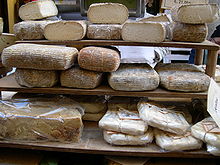起司的歷史

起司的生产始于7000多年前,早于有记载的历史,[1][2][3]而目前發現最早的起司製作直接证据,是在波兰庫亞維[4]和克罗地亚达尔马提亚海岸至今約七千多年前的陶製筛子。其中,后者有干燥的残骸,經化学分析後認為很有可能是起司。另外在瑞士纳沙泰尔湖的骨灰瓮文化住宅中也发现了有孔的陶器碎片,據推测,有可能是用來過濾起司的用具,[5]而它们可以追溯到西元前6,000年。
最早的起源
[编辑]相傳起司是起源於阿拉伯。約在六千年前,阿拉伯人將牛奶和羊奶放入皮革器皿中,作旅途解渴之用,繫於駱駝側。在艷陽高照的沙漠上顛簸行走數小時後,卻發現袋內的羊奶已分成兩層,一層透明狀的乳清及白塊凝脂。原來皮革器皿中含有類似凝乳酶的酵素,加上旅途顛簸搖盪及被太陽高溫照射,乳液隨之發酵,形成半固體狀態,最初的起司就這樣誕生了。[6][7][8]
硬盐奶酪是牛奶可以在炎热气候下保存的唯一形式。大约公元前4000年,撒哈拉沙漠上出現了乳制品。[9]在气候比中东凉爽的欧洲生产奶酪僅需要一些盐来保存。由于盐分和酸度较低,奶酪成为了微生物和黴菌的合适环境,進而使陈年奶酪具有了特殊的风味。
奶酪至今被發現最早的书面证据是乌尔第三王朝的苏美尔楔形文字文本,可追溯到公元前二千年初期。[10]最早的起司又酸又咸,质地与茅屋起司或现代菲達芝士相似。在青铜时代晚期的米诺斯-迈锡尼克里特岛,线形文字B碑记录了奶酪的盘点。[11][12][13]
古埃及、希腊和罗马
[编辑]
埃及制作奶酪的最早考古证据可以追溯到大约5000年前。西元2018年,开罗大学和卡塔尼亚大学的考古学家表示,他們在萨卡拉墓地中发现了距今約3200年,来自埃及的已知最古老的起司。[14]另外,在古埃及一處的墓葬壁画中发现了大約公元前2000年埃及奶酪制作的畫,可從中了解起司的製作過程。[15]
在希腊神话的中,奶酪制作在欧洲就已为人所知。[16]根据老普林尼的说法,奶酪在古罗马时代开始就成为一项复杂的企业。[17]在古罗马时代,珍贵的外国奶酪被运往罗马,以满足當地社会精英的口味。
古希腊神话将奶酪的发现归功于阿里斯塔乌斯。荷马的奧德賽(公元前8世纪后期)則描述了起司的生产和储存绵羊、山羊奶和奶酪的独眼巨人。
另外,古希臘哲學家伊壁鸠鲁给了他赞助的人一封信,要求提供一盘硬奶酪,以便他可以随时享用盛宴。普林尼记录了琐罗亚斯德以奶酪为生的罗马传统。[18]
到了罗马时代,奶酪制作已經是一门成熟的艺术,而乳酪也是常见的食品了。
後羅馬歐洲
[编辑]大多数起司的最早紀錄出現於中世纪后期。其中切达干酪的最早紀錄出現於西元1100年代,帕尔马干酪的最早紀錄出現於1597年,豪达奶酪干酪的最早紀錄出現於1697年,卡芒贝尔奶酪干酪的最早紀錄出現於1791年。[19]
另外,奶酪開始在欧洲变得多样化,各地都出現了自己的传统和产品,而庄园和修道院的奶酪制作也更强化了当地特色。[20]時至今日,英国有15種受保護的奶酪,[21]法国有50种,意大利有55种,[22]西班牙有26种。在總體上,意大利至少有400种奶酪。[23]与此同时,在罗马沦陷后的几个世纪里,欧洲奶酪艺术的發展缓慢。並成为长途贸易的主食,[24]也同時被视为了农民的食物。[25][26]

美洲
[编辑]根據來自英國的清教徒報告表示,印加人和其他安第斯文化已會食用骆驼奶酪。[27]然而,一些研究未能在这些文化中找到任何关于挤奶的参考。[28]
自欧洲殖民美洲以来,北美和南美都开发了当地的奶酪。大规模生产奶酪已经变得相当普遍,但近年來 ,卻有越来越多的美国人开始從事制作手工奶酪。[29]
中國
[编辑]在中国新疆的小河墓地中发现了公元前1615年的腌制奶酪。[30]
而今天新疆当地奶酪通常以芝士和相关奶酪的形式在南亚大部分地区生产或供应。另外中国西藏的奶酪种类繁多,云南的乳饼則类似于芝士。不過中国的主流文化并非以乳制品为中心,但包括云南在内的一些边远地区有着浓厚的奶酪传统。
现代
[编辑]起司在与欧洲文化一起传播之前,在欧洲、中东和北非最为普遍。而撒哈拉以南非洲、亚洲及其他地区和殖民前的美洲,則十分少見到起司這種食品。
大量生产
[编辑]1815年,第一家工业化生产奶酪的工厂在瑞士开业。
然而,大规模生产真正在美国取得成功,得要归功于来自纽约罗马的奶农杰西·威廉士,1851年,威廉姆斯开始使用来自邻近农场的牛奶以流水线方式制作奶酪。
1860年代开始大量生产凝乳酶。到1900年代,科学家们開始生产纯微生物培养物。以前,奶酪中的细菌来自环境或回收早期批次的乳清。纯培养意味着可以生产标准化的奶酪。奶酪的大规模生产使得贫困阶层很容易获得奶酪。因此,简单且经济效益高的奶酪储存解决方案广受欢迎,而陶瓷奶酪盘或奶酪钟成为延长家庭奶酪寿命的最常见方法之一,在1913年推出家用冰箱之前,一直在大多数家庭中流行。[31]
在二战时期,工厂制造的奶酪取代了传统的奶酪制作。从那时起,工厂一直是美国和欧洲大多数奶酪的来源。今天,美国人购买的加工奶酪比“真正的”工厂制造的奶酪还要多。[32]
參見
[编辑]参考資料
[编辑]- ^ 在達爾馬提亞海岸發現了7,200年歷史的奶酪製作證據. PHYS.ORG. 2018-09-05 [2022-07-16]. (原始内容存档于2023-07-15).(英文)
- ^ Hints of 7,200-Year-Old Cheese Create a Scientific Stink. National Geographic Society. 2018-09-05 [2022-07-16]. (原始内容存档于2020-12-24).
- ^ McClure, Sarah B.; Magill, Clayton; Podrug, Emil; Moore, Andrew M. T.; Harper, Thomas K.; Culleton, Brendan J.; Kennett, Douglas J.; Freeman, Katherine H. Fatty acid specific δ13C values reveal earliest Mediterranean cheese production 7,200 years ago. PLOS ONE. 2018, 13 (9): e0202807. Bibcode:2018PLoSO..1302807M. PMC 6124750
 . PMID 30183735. doi:10.1371/journal.pone.0202807
. PMID 30183735. doi:10.1371/journal.pone.0202807  .
.
- ^ Salque M, Bogucki PI, Pyzel J, Sobkowiak-Tabaka I, Grygiel R, et al. Earliest evidence for cheese making in the sixth millennium bc in northern Europe. Nature (Nature Publishing Group). 2012, 493 (7433): 522–525. PMID 23235824. S2CID 4322406. doi:10.1038/nature11698.
- ^ Toussaint-Samat 2009:103.
- ^ Ridgwell, Jenny; Ridgway, Judy. Food Around the World. Oxford University Press. 1968. ISBN 0-19-832728-5.
- ^ Reich, Vicky. Cheese. Moscow Food Co-op. January 2002 [December 11, 2012]. (原始内容存档于2012-05-30).
- ^ Carmona, Salvador; Ezzamel, Mahmoud. Accounting and accountability in ancient civilizations: Mesopotamia and ancient Egypt. Accounting and Accountability (Emeral Group Publishing). 2007, 20 (2) [9 December 2012]. doi:10.2139/ssrn.1016353. (原始内容存档于2014-07-06).
In the Old Sumerian period, cheese delivery quotas of herdsmen in charge were recorded, using jars with standardized liquid capacity as measures (the traditional grain measures), in contrast to archaic times when cheese was counted in discrete units
- ^ Simoons, Frederick J. The antiquity of dairying in Asia and Africa. Geographical Review (American Geographical Society). July 1971, 61 (3): 431–439. JSTOR 213437. doi:10.2307/213437.
- ^ In NBC 11196 (5 NT 24, dated Shu-Sin 6), the 'abra's of Dumuzi, Ninkasi, and I'kur receive butter and cheese from the 'abra of Inanna, according to W.W. Hallo, "The House of Ur-Meme", Journal of Near Eastern Studies, 1972; a Sumerian/Akkadian bilingual lexicon of ca 1900 BC lists twenty kinds of cheese.
- ^ The Linear B word tu-ro. Palaeolexicon. Word study tool for ancient languages. [2022-07-16]. (原始内容存档于2016-04-15).
- ^ τυρός. Liddell, Henry George; Scott, Robert; A Greek–English Lexicon at the Perseus Project.
- ^ Michael Ventris and John Chadwick, Documents in Mycenaean Greek, 2nd ed. (Cambridge University Press) 1973:572, 588; implications of modern pre-industrial Cretan pastoralists and cheese production for interpreting the archaeological record, are discussed by H. Blitzer, "Pastoral Life in the Mountains of Crete", 1990 (页面存档备份,存于互联网档案馆).
- ^ Ancient Egypt: Cheese discovered in 3,200-year-old tomb. BBC News. 18 August 2018 [August 20, 2018]. (原始内容存档于2023-07-15).
- ^ History of Cheese. accessed 2007/06/10
- ^ The archaic myth of the culture-hero Aristaeus, who introduced bee-keeping and cheese-making before wine was known in Greece.
- ^ The History Of Cheese: From An Ancient Nomad's Horseback To Today's Luxury Cheese Cart. The Nibble. Lifestyle Direct, Inc. [2009-10-15]. (原始内容存档于2019-05-08).
- ^ Pliny's Natural History, iii .85.
- ^ Smith, John H. Cheesemaking in Scotland - A History. The Scottish Dairy Association. 1995. ISBN 0-9525323-0-1.
- ^ Noted in passing by Maguelonne Toussaint-Samat A History of Food, 2nd ed. 2009:106.
- ^ British Cheese homepage. British Cheese Board. 2007 [2009-10-15]. (原始内容存档于2019-10-20).
- ^ Piani di controllo dei prodotti DOP e IGP: Formaggi. Ministero dell'agricoltura, della sovranità alimentare e delle foreste. [2023-03-02]. (原始内容存档于2023-05-08).
- ^ The Complete Guide to Italian Cheeses (and the 13 Kinds to Know). Kitchen Stories. [2023-03-03]. (原始内容存档于2023-06-09).
- ^ Details of the local costs and export duties in importing cheese from Apulia to Florence, ca 1310-40, are included in Francesco di Balduccio Pergolotti's Practice of Commerce, translated in Robert Sabatino Lopez, Irving Woodworth Raymond, Medieval trade in the Mediterranean world: illustrative documents, 2001:117, no. 46.
- ^ The stratification of medieval food is discussed in Stephen Mennell, All Manners of Food: Eating and Taste in England and France from the Middle Ages to the Present, 1996: "Eating in the Middle Ages: the social distribution of food", pp 41ff; Mennell observes, "Dairy produce very much remained identified with the lower orders and disdained by the grand", adding "one of the few ways in which peasants in the mountains of Provence had a dietary advantage over the archbishop [of Arles] was in their high consumption of cheese."
- ^ William Edward Mead, The English Medieval Feast, 1931 notes "the advice to avoid peaches, apples, pears and cheese, etc., as injurious to health" as unintelligible to moderns.
- ^ Milk in Pre-Columbian America | Dairy Moos. 12 February 2017 [2022-07-16]. (原始内容存档于2023-07-15).
- ^ Gade, Daniel W. Nature and Culture in the Andes. 1999 [2022-07-16]. ISBN 9780299161248. (原始内容存档于2023-07-15).
- ^ Heather Paxson, The Life of Cheese Crafting Food and Value in America, University of California Press: 56–59, 2013, ISBN 978-0-52-027018-3
- ^ Oldest Cheese Found. USA Today. [February 25, 2015]. (原始内容存档于2020-12-11).
- ^ Barfly Retro Fridge History. [26 September 2013]. (原始内容存档于2022-07-16).
- ^ McGee, Harold. On Food and Cooking Revised. Scribner. 2004: 54. ISBN 0-684-80001-2.
In the United States, the market for process cheese [...] is now larger than the market for 'natural' cheese, which itself is almost exclusively factory-made.
